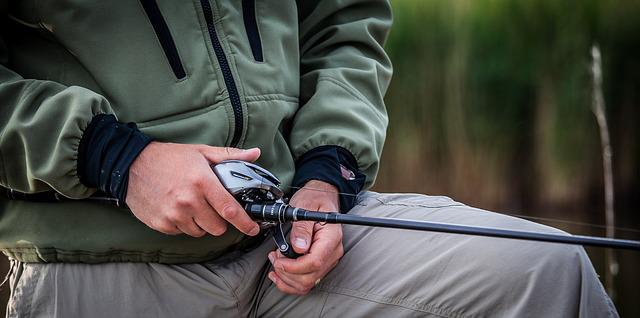How to Set up a Fishing Line for Saltwater
The intricacies of setting up a fishing line for saltwater fishing can be quite complex and are often subject to the specific conditions of the fishing environment as well as the targeted species. The selection of suitable rigging components such as swivels, connectors, hooks, lures, and weights becomes critical.
For instance, a Carolina Rig with an offset hook, bullet weight, bead, and swivel might serve as a versatile option. However, the process is not as straightforward as it appears, leaving us to ponder how to thread these components efficiently and safely.
Key Takeaways
- Understanding fishing rigs, knots, and baiting techniques significantly enhances your saltwater fishing success.
- Essential equipment includes offset hooks, pyramid sinkers, beads, swivels, and versatile rigs like the Carolina Rig.
- Choosing the right reel, maintaining it properly, and correctly attaching it to the pole are vital for effective casting and retrieval.
- Rig setup techniques, leader line application, and correct knot tying methods improve bait presentation and increase chances of a successful catch.
Understanding Saltwater Fishing Basics
To excel in the art of saltwater fishing, a comprehensive understanding of various types of rigs, hooks, weights, and fishing lines, along with the ability to adapt to different fishing environments is indispensable. One must grasp the nuances of diverse saltwater rigs such as surf fishing rigs, bottom fishing rigs, and pier fishing rigs.
The Carolina Rig is a perfect example, known for its versatility and effectiveness. It involves using elements like offset hooks, bullet weights, beads, and swivels for rigging. The leader, an integral part of this rig, is responsible for connecting the main fishing line to the hook and bait.
Mastering the art of tying a clinch knot is also an absolute necessity. This knot is highly reliable, ensuring that your hook stays connected to the leader even under the strain of a heavy catch. Then comes the skill to bait the hook, a crucial stage that can determine your success in attracting the target species.
Adapting to different environments for fishing by adjusting rigs based on water depth, conditions, and target species is equally important. This adaptability is key to improving your saltwater fishing skills. Thus, understanding these basics forms the foundation of successful saltwater fishing.
Necessary Equipment for Saltwater Fishing
Equipping yourself properly is a critical step towards successful saltwater fishing, and this involves selecting the right tools such as offset hooks, pyramid sinkers, beads, swivels, and versatile setups like the Carolina Rig. Each piece of equipment plays a unique role in enhancing your fishing experience, and understanding their functions can increase your chances of a successful catch.
Let’s delve into the specifics:
- Offset Hooks: These are essential for targeting saltwater species like redfish or snook. The unique design ensures a better hook set, which is instrumental in securing your catch.
- Pyramid Sinkers: These are critical when fishing in strong currents or deep waters. They keep your bait at the desired depth, nearer to where fish might be feeding.
- Beads: When added to your rig, they create an underwater noise that attracts curious fish to your bait.
- Swivels: These are critical in preventing line twists and ensuring the smooth movement of your bait in the water.
Additionally, a properly set up Carolina Rig, complete with a leader line, can adapt to various saltwater fishing situations. This versatility increases your chances of landing a fish, making it an invaluable tool in your fishing arsenal.
Locating the Reel Seat
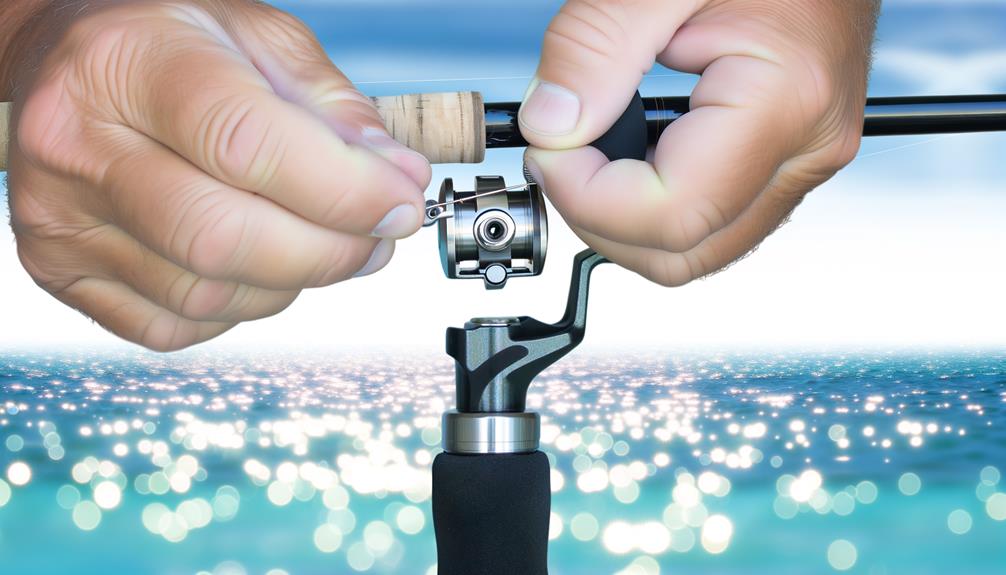
Identifying the reel seat, typically located at the base of your fishing rod near the handle, is a pivotal step in setting up your fishing line for saltwater fishing. This crucial component is easily recognizable by its divot or indentation, designed to hold the reel securely in place, thereby ensuring balance and stability in your line while fishing.
The table below provides an overview of key points to remember when locating the reel seat:
| Key Point | Description | Importance |
|---|---|---|
| Reel Seat Location | At the base of the rod near the handle | Ensures balance and stability |
| Identifying Feature | A divot or indentation | Securely holds the reel |
| Functionality | Secures the reel during casting and reeling | Essential for effective fishing |
| Role in Setting Up a Fishing Line | Integral part | Contributes to overall functionality of rod |
| End of the Line | Where line attaches to the reel | Ensures correct line set up |
Setting the Reel on the Pole
Setting the reel on the pole is a critical step in the process of setting up a fishing line for saltwater. The selection of a suitable fishing reel, understanding proper reel attachment techniques, and knowledge of maintenance for saltwater reels will be discussed.
Each of these points is essential to ensure effective casting, correct line retrieval, and long-term use of the equipment.
Selecting Suitable Fishing Reel
When it comes to saltwater fishing, selecting a suitable reel is of utmost importance, particularly one crafted from corrosion-resistant materials like stainless steel and aluminum to withstand the harsh saltwater conditions.
- Choose a reel made of corrosion-resistant materials. For a long-lasting Saltwater Fishing Pole, the reel should resist damage from the elements.
- The reel should have a high line capacity and a smooth drag system. These features allow you to handle larger saltwater species effectively.
- Pay attention to the reel size. To add a leader and ensure optimal balance, the reel size should match your fishing rod.
- Look for additional features like anti-reverse systems and sealed bearings. These features add durability and longevity to your reel, providing a more enjoyable fishing experience in the long run.
Proper Reel Attachment Techniques
The intricate process of correctly attaching the reel to the fishing pole is a crucial step that ensures seamless operation and efficient casting for saltwater fishing. This technique not only aids in proper casting but also contributes to effective reel maintenance and line management.
| Steps | Description |
|---|---|
| Identify Reel Seat | Locate the divot at the bottom of the rod |
| Secure Reel | Place the reel in the divot, using the black ring for stability |
| Thread Line | Thread the fishing line through the eyelets on the pole |
| Add Weight | Add a barrel weight to the line for balance and casting distance |
| Confirm | Correct attachment ensures smooth operation and efficient casting |
This comprehensive procedure encapsulates the essentials of setting up a reel, fostering a sense of belonging among saltwater fishing enthusiasts.
Maintenance of Saltwater Reels
Building upon the fundamentals of proper reel attachment, it is equally important to delve into the maintenance of saltwater reels, particularly regarding how to set the reel on the pole for optimal performance and longevity.
As an angler, your reel maintenance and casting techniques directly influence your success in catching saltwater species. To set the reel effectively, follow these steps:
- Locate the reel seat by identifying the divot at the rod’s bottom.
- Place the reel in this divot and secure it using the accompanying black ring.
- Carefully thread the fishing line through the rod’s eyelets, ensuring smooth casting.
- Add a barrel weight to the line by threading it through the weight’s eye, improving casting distance and accuracy.
Maintaining your saltwater reel is not just about the gear; it’s about belonging to a community of skilled anglers.
Lining Your Fishing Pole
Properly threading the fishing line through the guides on your pole is a critical step to ensure smooth casting and retrieval during your saltwater fishing excursion. This key aspect of line maintenance involves careful attention to detail and practice.
Your line choice depends on the targeted fish species and prevailing conditions. A suitable pound-test line will facilitate efficient casting techniques and retrieval methods. For saltwater fishing, consider a monofilament line known for its stretch and shock-absorption properties.
Secure the line on the reel spool using an arbor knot, an essential knot tying skill to prevent line slippage. Regular line inspection before each fishing trip is crucial to detect any signs of wear or damage that may compromise your fishing effort.
To illustrate, the table below summarizes the key steps in lining your fishing pole:
| Steps | Key Considerations | Relevant Skills |
|---|---|---|
| Threading | Smooth casting and retrieval | Line maintenance |
| Choosing line | Target species and conditions | Line choice |
| Knot tying | Prevent line slippage | Knot tying |
| Inspecting line | Detect wear or damage | Line inspection |
In mastering these techniques, you ensure a successful saltwater fishing experience.
Application of Barrel Weight
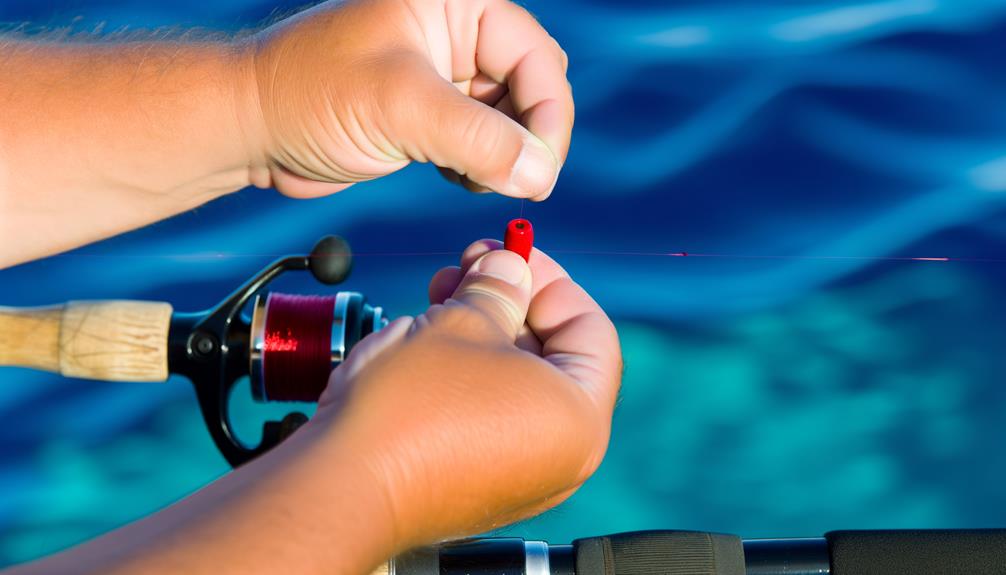
Incorporating a barrel weight into your saltwater fishing line setup can significantly enhance the bait’s sinking depth, line stability, and casting accuracy. When properly applied, a barrel weight can make a dramatic difference to your fishing experience.
The barrel weight serves a few key purposes in saltwater fishing:
- Weight distribution: The weight of the barrel provides stability and balance to your line when casting and reeling, leading to a more controlled and accurate cast.
- Sinker placement: Proper positioning of the barrel weight on the line can greatly enhance the presentation of your bait, making it more attractive to your target fish.
- Depth control: By adjusting the barrel weight, you can control the depth at which your bait sinks, allowing you to target fish at different depths effectively.
- Versatility: Barrel weights come in various sizes. Choosing the right size for specific conditions and target species can greatly increase your success rate.
In essence, the application of barrel weight is an art within the realm of saltwater fishing. Mastering it not only improves your chances of a good catch but also deepens your connection with the art of fishing.
Attaching the Swivel
Following the careful application of the barrel weight, the next critical step in setting up a successful saltwater fishing line involves attaching the swivel. This seemingly small piece of tackle plays a significant role in enhancing your fishing experience. It’s essential to understand the swivel mechanics and swivel selection for maximum utility.
The swivel should be selected based on the weight capacity of the main line and the target fish species. This ensures that the swivel can withstand the pull and tug of the fish without breaking off. Thread the main line through one of the swivel’s rings, ensuring it fits securely and tightly.
Swivel benefits are plentiful, most notably preventing line twist and tangles. This allows for smoother casting and retrieval, thereby enhancing your overall fishing experience.
| Swivel Benefits | Description |
|---|---|
| Line Twist Prevention | Reduces chances of line entanglement |
| Smoother Casting and Retrieval | Facilitates efficient fishing |
| Enhanced Bait Presentation | Attracts more fish |
| Suitable for Various Species | Versatility in saltwater fishing |
| Improved Rig Performance | Strengthens fishing setup |
Ultimately, proper swivel attachment boosts the strength and performance of your rig setup, leading to fruitful fishing outings.
Tying the Fisherman’s Knot
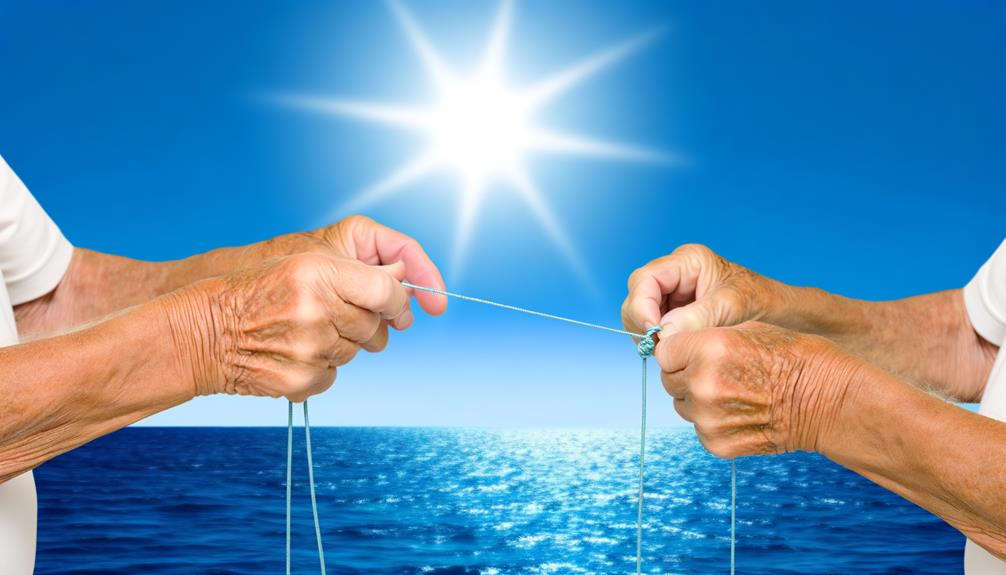
A crucial component in setting up a successful saltwater fishing line is mastering the art of tying the Fisherman’s Knot, also known as the Improved Clinch Knot in fishing circles. This knot is a popular choice for securing hooks, lures, or swivels to the fishing line due to its strong and reliable connection. It works well with various types of fishing lines, including monofilament, fluorocarbon, and braided lines.
Here are the detailed steps of tying a Fisherman’s Knot:
- Thread the end of the line through the eye of the hook and double back, making five turns around the standing line.
- Pass the end of the line through the first loop formed behind the eye of the hook.
- Next, pass it through the big loop.
- Wet the knot with saliva and pull both ends to tighten securely.
This knot tying technique is particularly effective in a saltwater environment due to its knot security and line strength. It’s essential to tighten the knot correctly to prevent line slippage, ensuring a sturdy hook attachment. With practice, tying the Fisherman’s Knot will become second nature, enhancing your saltwater fishing experience.
Adding the Leader Line
The leader line, a crucial element in saltwater fishing, is the direct link between the main line and the hook or lure.
Selecting an appropriate leader line, specifically fluorocarbon, can enhance visibility underwater, thereby elevating your chances of a successful catch.
The attachment of this leader to your main line demands precision and a sturdy knot in order to prevent any possible breakage during the tug of a catch.
Choosing the Right Leader
In saltwater fishing, selecting a suitable leader line is of utmost importance, as it can significantly influence your success rate. Here are four key considerations when choosing the right leader:
- Leader material options: Fluorocarbon is recommended for its abrasion resistance and low visibility in clear water conditions.
- Leader line weight: Choose between a heavier 30-50 lb test line for larger, toothy saltwater species, or a lighter 10-20 lb test line for finicky fish or finesse situations.
- Leader line diameter: This should ideally match the main line diameter to ensure smooth casting and minimal impact on lure action.
- Leader line knot tying techniques: Secure your leader line to the main line using a strong knot such as the double uni knot or the Albright knot.
Use these guidelines to enhance your saltwater fishing experience.
Attaching Leader to Line
Having chosen the right leader based on material, weight, diameter, and knot tying techniques, we now move on to the crucial step of attaching this leader line to your main fishing line.
Knowing the different leader types and knot variations is key in this process. Use a secure knot such as the Fisherman’s Knot to ensure a firm connection between your main line and leader.
The leader length should range between 15-24 inches, providing flexibility and reducing the chance of spooking fish. Depending on the conditions, you might opt for a fluorocarbon leader for its invisibility or a wire leader for toothy fish.
Hook Attachment Techniques
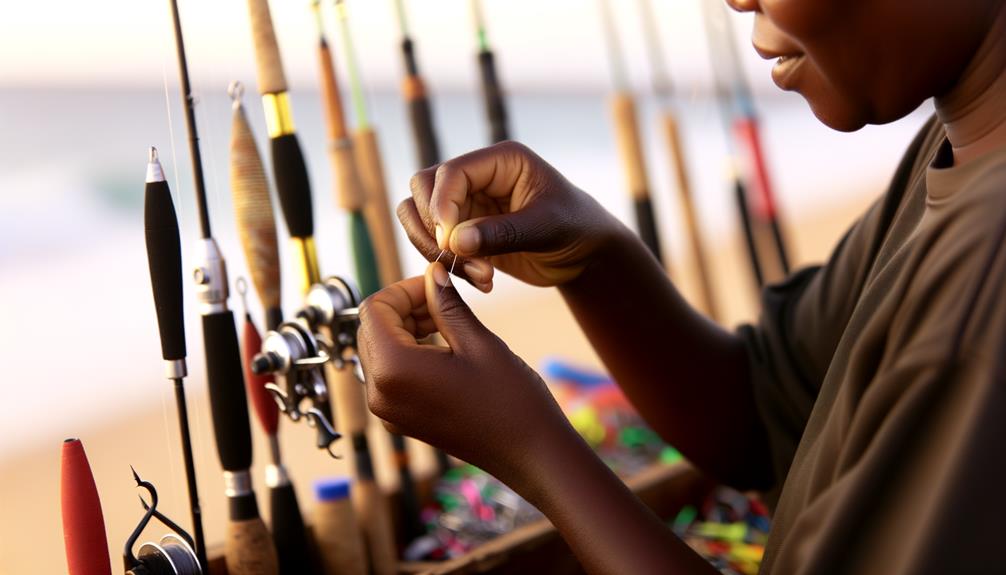
Mastering various hook attachment techniques is essential for successful saltwater fishing. These techniques include the use of a Palomar knot, ensuring hook sharpness, utilizing a loop knot, opting for a snell knot, and diligently checking knot strength while trimming excess line.
- The Palomar knot is renowned for its security and provides optimum knot strength evaluation. This knot is easy to tie and extremely reliable, making it a favored choice among experienced anglers.
- Ensuring hook sharpness is pivotal to enhance hooking efficiency. Sharp hooks penetrate fish mouths more easily, ensuring a better catch rate. Regular hook sharpening tips include using a file or sharpening stone and always checking the point before casting.
- The loop knot is an excellent choice for enhancing bait movement and presenting the bait naturally. The loop knot benefits are exemplified when using live bait or lures as it allows them to move freely, mimicking the natural movement of prey in the water.
- The snell knot offers advantages such as aligning the hook with the line, which can increase hook-up ratios. Lastly, trimming excess line after checking knot strength ensures a clean, efficient setup, thereby aiding in an effective saltwater fishing experience.
Frequently Asked Questions
How Do You Rig a Salt Water Fishing Line?
To rig a saltwater fishing line, prioritize line strength to endure rigorous conditions. Knot techniques should be mastered for secure connections. Bait selection is crucial, aligning with the target species’ feeding habits for successful catches.
How Do You Set up a Saltwater Fishing Setup?
Setting up a saltwater fishing setup involves careful saltwater lure selection, regular tackle maintenance, and using essential fishing gear. Creating the right rig, baiting the hook, and casting correctly are all paramount to success.
What Is the Best Rig for Saltwater Fishing?
The best rig for saltwater fishing depends on rig durability, bait choices, and seasonal variations. The Carolina Rig is often preferred for its versatility, effectiveness, and adaptability to different saltwater environments and fish species.
How Do You Put Weight on a Saltwater Fishing Line?
Weight placement on a saltwater fishing line is vital for optimal lure depth and casting balance. Consider the ideal weight size depending on water conditions and target species, ensuring secure attachment for consistent performance.
Conclusion
In conclusion, mastering the art of setting up a saltwater fishing line requires a sound comprehension of fishing basics, meticulous selection of equipment, and deft application of techniques.
From locating the reel seat to attaching the hook, each step signifies a rhythm in the symphony of preparation.
By intertwining knowledge, adaptability, and safety, anglers can craft an effective saltwater fishing line setup, an indispensable tool in their quest to conquer the briny deep.


